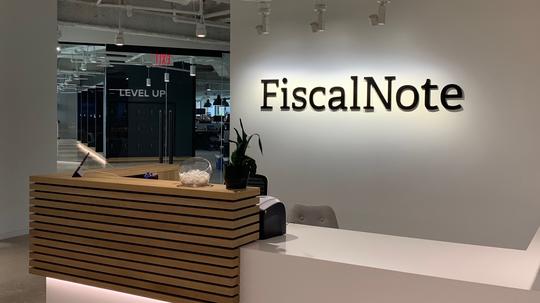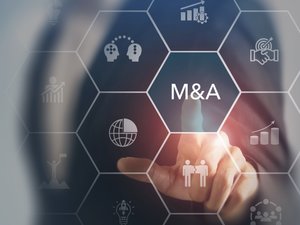
This story is part of a series of audio interviews, for which DC Inno is partnering with local radio program What’s Working in Washington. The interviews are conducted by D.C. investor Jonathan Aberman, founder of Amplifier Ventures and director of the Tandem Product Academy. For potential interview requests, contact Kieran McQuilkin at kmcquilkin@americaninno.com.
Whether you’re a lawmaker, lobbyist or layman, it's difficult to have a full grasp of the bills being written and passed in all levels of government, and what effect they’ll have on constituents. Even tougher is understanding the support behind each bill, and which are most likely to impact a given industry.
D.C.-based tech company FiscalNote, a government data firm that last year doubled the size of its headquarters, is one of the major players in that industry. It recently stretched into the publishing world with the $180 million acquisition of CQ Roll Call, which just expanded into China and brought on several new executives – but its bread and butter is software that analyzes government documents.
To learn more about how the company uses AI to pull meaning out of complex, variable legislative processes, we spoke with Vladimir Eidelman, VP of research at FiscalNote.
Listen to the full interview here (8 minutes):
[audio mp3="https://www.americaninno.com/wp-content/uploads/2019/04/040519WWiWPodcastEidelman_6ssp.mp3"][/audio]
Below is a full transcript of the radio interview.
ABERMAN: Tell me about FiscalNote. What’s it do?
EIDELMAN: So I think we started at a really good place. As in most things today, there’s just a ton of information coming at you, for any decision that you’re making. It’s really hard to understand what’s relevant and what’s not. And so, the core of what FiscalNote was founded on was, how can we enable people to better understand what’s going on, especially if they have to keep up with all the policy changes and things going on in the government, to take in all the data that they need to, and make decisions to react or act in ways that help their organization, and inform their advocates, to understand how policy changes are going to affect them?
And so, the first thing we need to do is collect a lot of information, collect a lot of data. So, we collect local, state, federal data as it comes in, but that is only so good. You need to actually make sense of it. So, the second part is where the applied AI team comes in, the team that I lead, which is to actually create analysis on top of that information that, hopefully, is practical AI tools that enable people to do the things that they’re already doing, but hopefully a little bit better. Maybe faster, maybe a little smarter.
And so, I think there’s a bit of a false dichotomy that’s presented in the media often, between AI versus human. Whereas I think the real message should be human without AI versus a human period. And so, what AI is supposed to do is enhance the things that you’re already doing.
And so, there’s a lot of routine work, a lot of data culling and munching, that someone today is probably doing to just even understand the current state of affairs. Whereas with AI, what it’s really good for is processing and finding patterns in a lot of data. But it doesn’t know if those are relevant patterns, if those are informative. We need an expert, a human to do that. Taking all of that analysis to understand, what am I going to do with it? How am I going to act on it? And hopefully, we make that decision point a little bit easier to digest.
ABERMAN: It’s funny, because as you’re describing it, I think back to the introduction of steam power, and how a lot of people were concerned how steam power was going to displace manual labor, it was going to displace workers. And in fact what happened was, steam power made made things more efficient, and humans basically sat on top of steam power, and started to create all these amazing new products and technologies and businesses by using steam power.
Many people, when they talk about artificial intelligence, focus on the the job substitution. They don’t focus on the fact that there’s nothing that prevent humans from sitting on top of a AI, as you say, and being more effective, more productive, and ultimately creating more value. That’s what you’re getting at, right?
EIDELMAN: That’s exactly right. So, I think what we’ve seen in the recent years, is the growing popularity and public discourse about AI, and I think there’s a couple of misperceptions that come with that. And one is that it is that AI is coming over and taking over general intelligence, and that’s not the case. And so, the kind of things that research labs, and companies like us, are working on are practical tools. How do we actually apply AI in ways that enhance, not substitute, what people are doing? And so there might be sub-tasks that AI can completely cover, but there’s no end-to-end replacement of anyone’s job. It’s really understanding, within one workflow that someone has, let’s say they’re trying to understand how a new law coming out, or new regulation coming out, is going to change the way that they have to make a product.
And so what we have, for instance, one practical system we have is, taking all the comments from regulations, and understand the stance that everyone who’s commented on that regulation has. Whether they’re for or against, and why. So, breaking it down to the themes. So that’s a real job, a regular attorney today will take in all the comments, review them for their client, and say, here are companies for and against. And after that, the attorney has to figure out, OK, what are we going to do? How are we going to write our own comment? How are we going to plan a compliance strategy within the company to actually comply with these changes?
And so, that first part that doesn’t really need someone with a law degree to just review the comments. We can do that part automatically, and actually get the lawyer going faster to the point where they actually have to apply some inference, some narrative, some story skills, and that’s kind of what we’re doing with of all of the things that we have in the product today.
ABERMAN: I would assume that AI, because it has the ability to extract patterns, would be able to actually figure out where there was Astroturf in a movement and where there was actually true depth, or where in a constituency base there actually are influencers. I mean, there’s a lot of things. That’s what I mean, and I think about, for example, the way a lot of the local NGOs are using social media tools to figure out who the influencers are within their social media reach, so they can know who to hit. It seems to me that there are all these different places where AI applies these days. So ultimately, I guess your hypothesis is that you can’t really deal with politics today without having technology on your side.
EIDELMAN: Exactly. It’s that same kind of analogy. It’s not AI versus human, it’s human who has some sort of technology supporting their work. And you can do a lot more as a person, as in your cognitive skills, your social skills, and understanding the environment. So the data that we collect is not the only data that’s relevant to our algorithms, to our models. The data that you, clients, journalists now, our media arm, all that information that they process and collect, that helps inform those algorithms and that model.
So the work that you’re doing outside, and going to those parties, and talking to your advocates is super critical. That’s the thing that you should be doing. What you shouldn’t be doing is sitting at your desk reading through a thousand-page document, to try to understand that one line that might be relevant. So, we can try to figure that out for you. We can try to figure out, what are the most important sentences or paragraphs within this thousand pieces of a piece of legislation? Where did those paragraphs come from, if they may have been reintroduction from another piece of legislation that you might have lobbied for, advocated for, in the past?
We can build that social graph of people that you might know that might know someone else, and their advocate network, or their lobby network, or their friends on other kinds of social media. Using that kind of pattern recognition, then you can be much more informed when you go into a meeting on the Hill, and say, well here’s what you did, here’s what we think we want to be done, and how do we get there.
ABERMAN: Well I got to tell you, Vladimir, I really appreciate you coming in the studio today. It’s it’s always great to meet a technologist who’s actually doing something that’s changing things in a positive way. So, congratulations to you and FiscalNote. Thanks for joining us today.
EIDELMAN: Absolutely. Thank you so much.




